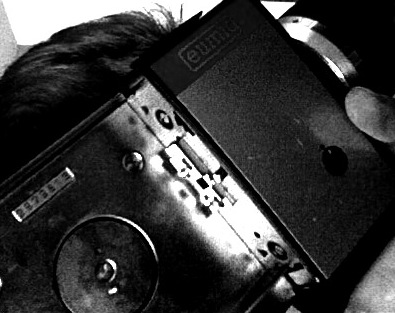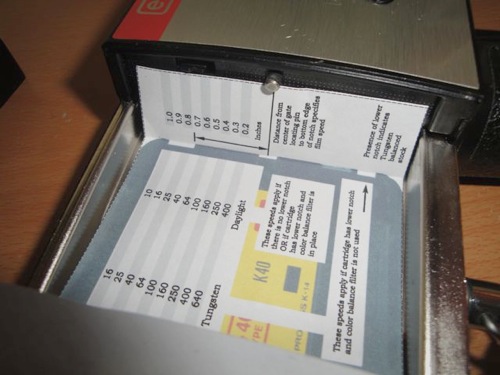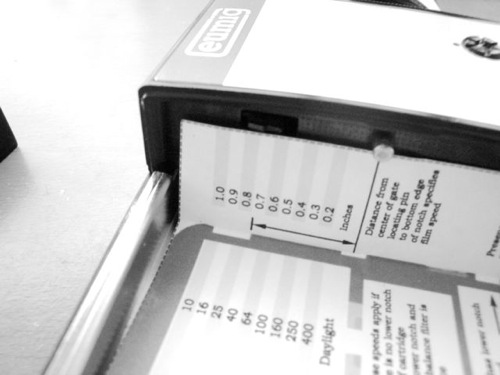This is topic Eumigette 2 - Film Speeds? in forum 8mm Forum at 8mm Forum.
To visit this topic, use this URL:
https://8mmforum.film-tech.com/cgi-bin/ubb/ultimatebb.cgi?ubb=get_topic;f=1;t=005837
Posted by Krystof Michalsky (Member # 2317) on November 23, 2010, 03:09 PM:
Hello,
I own an Eumigette 2 super 8 camera, dated from 1970-71. I would like to ask if you know what film speeds does this camera detect automatically ? I measured two speeds thanks to the cartridge notch ruler, but I can't know what is the film speed when the notch isn't engaged, if you know what I mean. You can see the pin has two positions on it, and a third when the notch isn't detected. I measured 25/40 ASA and 40/64 ASA on the pin (daylight/tungsten) but I can't know what is the speed when the notch isn't detected. I'd like to use Ektachrome 100D film so I hope the 3rd speed is 64/100 ASA. Could you help me please ?
Here's a picture of the pin :

Thanks in advance.
Posted by Douglas Meltzer (Member # 28) on November 23, 2010, 10:41 PM:
Krystof,
Welcome to the Forum!
There's conflicting information from 2 different websites. According to this site, the Eumigette 2 automatically exposes for 25/40, 40/64 and 64/100 ASA (daylight/tungsten).
In an amazing coincidence, the site gives you credit for photography and data!
However, according to an article that can be downloaded from here, the Eumigette is classified as a camera that cannot expose 64T or 100D properly.
Can any members out there clear this up?
Doug
Posted by Krystof Michalsky (Member # 2317) on November 24, 2010, 07:37 AM:
Thanks for the reply. In fact, as I said I measured the film speeds the camera can detect with a notch ruler, and according to it, the camera detect 25/40ASA and 40/64 ASA (d/t). So this should be correct, shouldn't it ? Then I guessed that the third film speed oughta be 64/100 ASA (d/t) but now I realized that it could well be 100/160ASA too, and I don't know how to find out which is this last film speed.
What's more, I cannot understand why the camera wouldn't work with Ekta 64T since I measured with the notch ruler that it detects films with 40/64 ASA. Don't forget I'm talking about Eumigette "2". Even if it may sound strange, it has not many things in common with Eumigette "1", the notch can be different. As you can see, the notch onmy Eumigette 2 has two positions, which means there are 3 in total. So there must be a third speed (and not only 40 and 160 as the article says).
I guess the best solution would be to read the manual but I can't get hold of it. Would anyone here have it ?
Lastly, the reason why there is credit to me on this site is because I contacted the owner with this information, asking him from where he got it. He relied on my deductions, among which the last (the 64/100 ASA speed) could be wrong.
I hope this reply is not too long :-)
PS: Here are the proofs ! ![[Big Grin]](biggrin.gif) You can see the notch has two steps, plus a third position when it isn't engaged.
You can see the notch has two steps, plus a third position when it isn't engaged.


Posted by Krystof Michalsky (Member # 2317) on November 25, 2010, 12:59 AM:
Anyone could help me, please ? ![[Confused]](confused.gif)
Posted by Alexander Lechner (Member # 1548) on November 25, 2010, 02:41 AM:
I don't know this camera but I would say that it is very likely that the third speed is 100/160 ASA. I have been working a lot with Eumig Mini 3 and 5, and I also tried the Viennette 3. What I learned from them is: 100 daylight does NOT mean it understands a 100 ASA daylight film - it means if you operate them with a tungsten balanced 160 ASA film (which was available then) in daylight you will have an actual speed of 100 (because of the filter).
So if you want to use the E100D you have to manually disengage the filter AND put the backlight control to +1 (I assume the Eumigette 2 has got that).
I would go for it.
Posted by Krystof Michalsky (Member # 2317) on November 25, 2010, 11:06 AM:
Thanks for your answer.
So either I use 100D with filter off and put the backlight on (position X) but it will be a little bit underexposed, or I could also use a 50 ASA film, as the Wittner Chrome V50D, and put the backlight on and it would be perfect ? Am I correct ?
Posted by Alexander Lechner (Member # 1548) on November 25, 2010, 12:12 PM:
When you use the 100D with filter off and backlight correction on you overexpose 1/3 of a stop, so you won't notice.
With the V50D I don't know; it depends how it is notched and how it corresponds with the pin in the camera. I only tried V50D once in a camera that understands all other films and got complete overexposure - didn't check the notching beforehand though.
Posted by Krystof Michalsky (Member # 2317) on November 25, 2010, 01:22 PM:
Normally, without backlight it would underexpose a 100 ASA film, since it will shoot it as a 160ASA film. How much does the backlight modify the opening of the diaphragm ? Won't it be underexposed of 1/3 stop ?
Posted by Alexander Lechner (Member # 1548) on November 25, 2010, 02:26 PM:
100D and 160T cartridges are notched the same way only that the 100D cartridge doesn't have the filter notch. The camera thinks that it is always dealing with a 160T cartridge - so when you disengage the filter it is set on 160 ASA. With the backlight control you add one stop, which makes it 80 ASA; this is less sensitive than 100 ASA so the diaphragm has to open a bit more - the film gets 1/3 stop overexposed.
Posted by Krystof Michalsky (Member # 2317) on November 25, 2010, 02:58 PM:
Got it. Thanks a lot ![[Smile]](smile.gif)
Posted by Thomas Dafnides (Member # 1851) on November 25, 2010, 10:56 PM:
If kodak wanted to promote super 8 , why didn't they make the cartridge film work compatible with the cameras and their meter systems? It seems like they mock the whole original system.
Posted by Alexander Lechner (Member # 1548) on November 26, 2010, 12:18 AM:
Hello Thomas!
As much as I do like the Eumig products, the later cameras were surely not high end products. Kodak must assume that mostly "expensive" cameras survived and are left to use nowadays; these cameras can meter most notch combinations without problem.
Visit www.film-tech.com for free equipment manual downloads. Copyright 2003-2019 Film-Tech Cinema Systems LLC

UBB.classicTM
6.3.1.2

![[Big Grin]](biggrin.gif) You can see the notch has two steps, plus a third position when it isn't engaged.
You can see the notch has two steps, plus a third position when it isn't engaged.

![[Confused]](confused.gif)
![[Smile]](smile.gif)